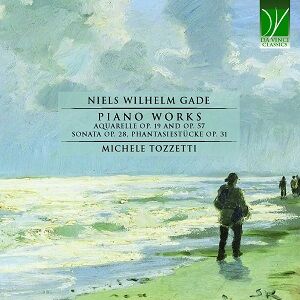
Niels Gade (1817-1890)
Piano Works
Aquarelle Op.19 (1849-50)
Sonata in E minor Op.28 (1840 rev.1854)
Phantasiestücke Op.31 (1855)
Aquarelle Op.57 (1881)
Michele Tozzetti (piano)
rec. 2022, Impronte Records, Rocca Priora
Da Vinci Classics C00685 [63]
Niels Gade’s name isn’t entirely unknown but little if any of his music graces the concert hall
nowadays. In his day he was much admired; in his home town of Copenhagen the Royal Danish
Orchestra, in which he played violin, premiered his op.1 concert overture Efterklange af Ossian and
his first Symphony written in 1841-2 was admired by Mendelssohn who premiered it with the
Gewandhaus Orchestra in Leipzig where Gade was to make his home until 1848. In that time he
was entrusted with conducting the premieres of Mendelssohn’s Violin Concerto and Schumann’s
Piano Concerto and upon returning to Denmark his experience and fame brought him the position
of director of the Copenhagen Musical Society which flourished under his leadership. Choral and
Symphonic music brought him fame but his sets of short piano pieces, most of them within the
reach of the gifted amateur, would have familiar in many households – I remember an old Augener
edition of his music sitting amongst my grandfather’s collection. His first set of ten Aquarelles is
perhaps his most recorded piano work and Italian pianist Michele Tozzetti adds Gade’s other set of
five written some three decades later. To complete the disc he plays the Phantasiestücke, fantasy
pieces, and the large scale Sonata, both written in the mid-1850s though Gade started writing the
Sonata in 1840 at the same time as he was writing Efterklange af Ossian.
The Aquarelles are short character pieces in the style of Mendelssohn; the fifth of the first series,
Barcarolle, could have come straight from the Songs without Words with its engaging melody and
flowing accompaniment. Amongst the others are a capering Capriccio, three Scherzos, all studies in
light staccato playing as is the very Mendelssohnesque final Capriccio from the later set, alternating
thoughtful moments with passages of bustling fingerwork. More lyrical are the elegie, romance and
novellette from the first set and the romanze and nocturne, a baritone-soprano duet, from the later
set.
The booklet description of Gade as a great nationlist composer is not apparent in these attractive but
very mid-European pieces. It is only in the later series and the Phantasiestücke, also published as
Folktunes, that hints of folk music appear. The third of the fantasy pieces brings vigorous dance and
folk-elements together and dance seems to be the common element here; the first is a march that
could be from southern Europe and the sprightly leaping figuration of the second is contrasted with
a more serious mazurka to complete the set. The Sonata in E minor grew out of early sketches and
only reached its final form after 15 years during which Gade had heard and been influenced by
Liszt’s Sonata in B minor. Gade acknowledged the influence though there is only a little of that to
be heard; once again it is Mendelssohn and Schumann that one is aware of most clearly in its four
movements. The opening celebrates its home key with a dramatic descending E minor arpeggio in
octaves before the main theme sings over a rushing left hand accompaniment. The second
movement is a beautiful song without words that has hints of Schubert in its figuration and a more
impassioned section in the unrelated key of E flat. The third movement is consumed with a
syncopated rhythm throughout that gives it a limping lilt and the finale is a whirling, virtuosic
tarantella.
For the most part the performances here are competent rather than inspired. I don’t find that Tozzetti
shapes these pieces with anything like the character and imagination that Christina Bjørkøe brings
to these pieces in her cpo recital (7776282 review) or Marianna Shirinyan on Dacapo
(8.226122 review) and there is a world of difference between them in a work such as the humoreske
op.19 no.4 – bubbly and charming from Bjørkøe and Shirinyan but foursquare and plodding from
Tozzetti – is this really allegro molto e con leggiarezza? It is not only about speed though; Tozzetti
sounds rather pedestrian in many of these pieces. In the opening of the Sonata he loses dramatic
impact immediately when the opening octaves, already quite stately, slow up and while the opening
theme unfolds quite nicely it does not have the fire that the allegro con fuoco asks for. The playing
is quite literal in the next two movements and the phrasing that Bjørkøe and Shirinyan achieve
within each bar as well as through a longer statements, playing laterally rather than vertically, is
missing from Tozzetti’s performance. In the first of the Phantasiestücke Tozzetti sounds like he is
going through the motions compared to Shirinyan’s taut performance and the story is the same in all
these pieces. It must be said that Tozzetti is certainly not helped by the very close miking, boomy
resonance and boxy sound of the 1899 Bechstein, quite a let down from the good sound of other Da
Vinci recordings I have heard. For this repertoire I would not hesitate in recommending Marianna
Shirinyan’s recital and as a bonus she includes two other short pieces, Aquarel in A major and
Chanson danoise.
One point to mention is that the order of Aquarelles Nos.8, 9 and 10 is mixed. No.9, Novellette is
track 8, no.10 Scherzo is track 9 and no.8 intermezzo is track 10.
Rob Challinor
Availability: Da Vinci

















